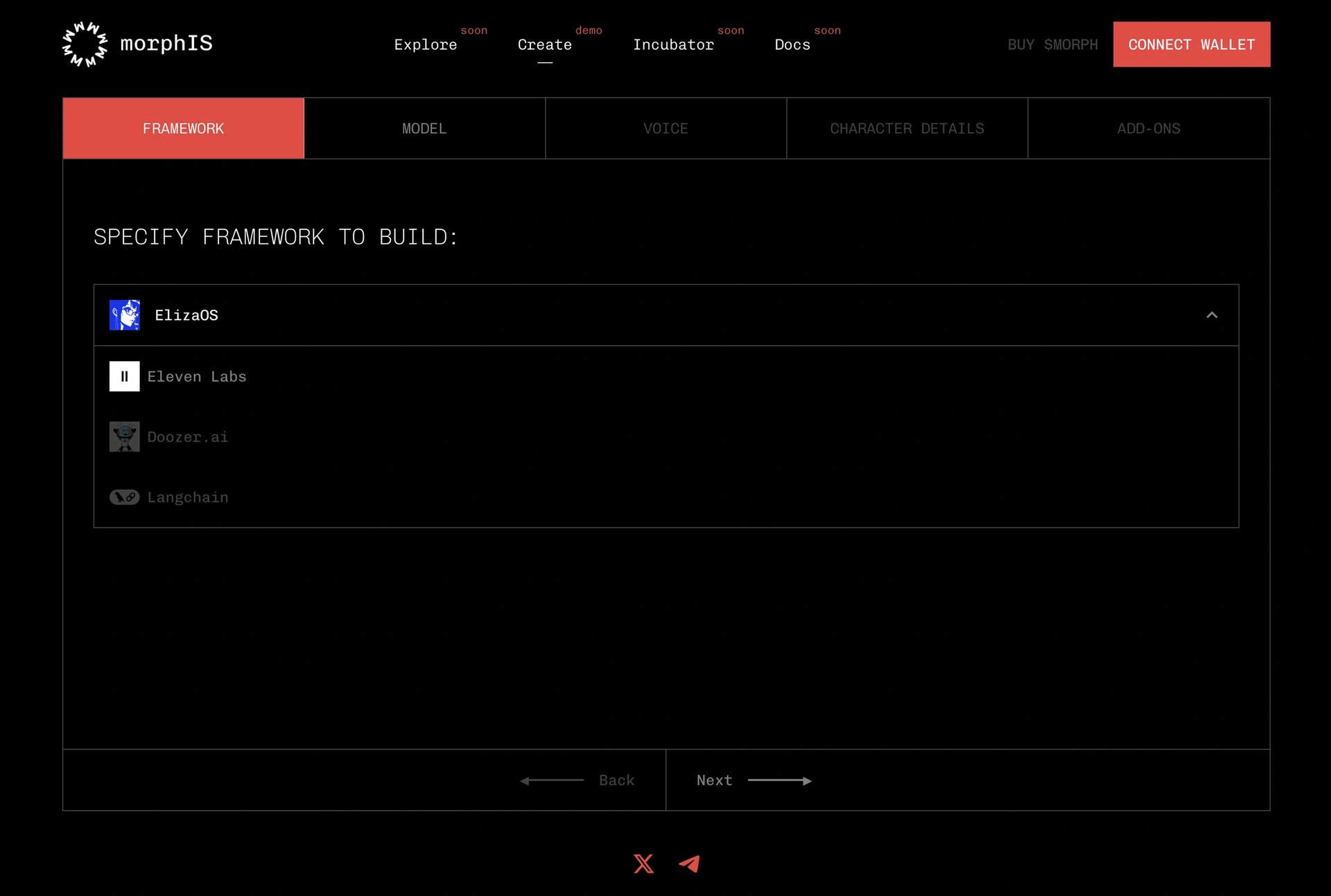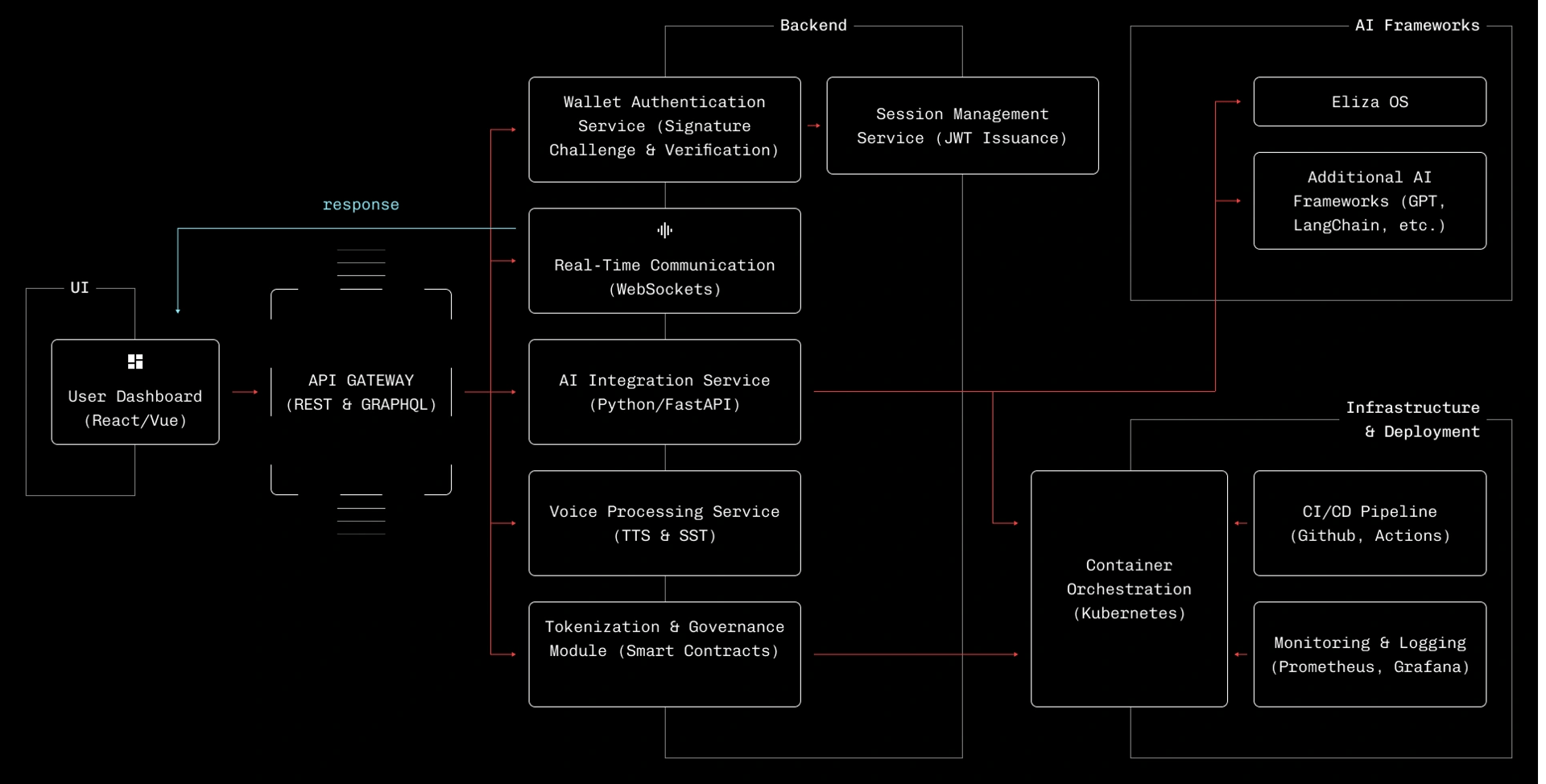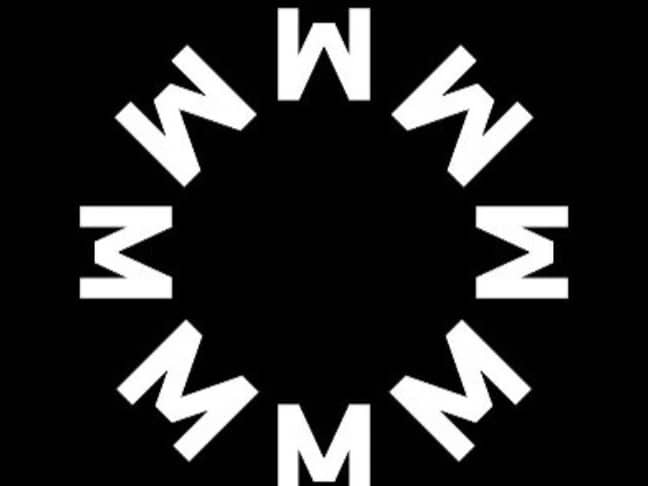위키 구독하기
Share wiki
Bookmark
Morphis
Morphis
Morphis 플랫폼을 통해 사용자는 코딩 지식 없이도 AI 에이전트를 구축, 테스트 및 배포할 수 있습니다. Web3 및 소셜 미디어 플랫폼을 포함한 다양한 디지털 환경과 상호 작용할 수 있는 모듈식 AI 에이전트 생성에 중점을 둡니다. [1]
개요
Morphis는 컨테이너화된 마이크로서비스 아키텍처를 사용하여 특수화된 AI 에이전트를 생성하고 관리하도록 설계된 노코드 플랫폼입니다. AI 프레임워크 집계기 역할을 하여 사용자가 다양한 AI 시스템을 선택하고 실시간 데이터 액세스, 블록체인 기능 및 통신, 비즈니스, 마케팅을 포함한 여러 부문의 타사 통합과 같은 추가 기능을 통합할 수 있도록 합니다.
이 시스템은 모듈성을 기반으로 구축되어 사용자가 맞춤형 기능을 위해 작업별 구성 요소를 사용하여 에이전트를 조립할 수 있습니다. Morphis는 실시간 통신을 위한 음성 상호 작용을 지원하며 사용자 지정 토큰 또는 미리 정의된 본딩 곡선을 통한 토큰화 옵션을 포함합니다. 유연한 통합 기능을 통해 사용자는 Web3 및 기존 Web2 환경의 도구를 사용하여 에이전트를 향상시킬 수 있으므로 코딩 기술 없이도 많은 사용 사례를 지원합니다. [4]
기능
AI 에이전트 생성

Morphis는 특정 역할과 환경에 맞게 사용자 지정된 AI 에이전트를 구축하기 위한 간소화된 노코드 프로세스를 제공합니다. 사용자는 에이전트의 기반 역할을 하는 ElizaOS와 같은 AI 프레임워크를 선택하는 것으로 시작합니다. 그런 다음 OpenAI의 GPT 및 Anthropic의 Claude와 같은 옵션을 포함하여 고급 AI 모델을 선택하여 에이전트의 핵심 지능을 정의합니다. 사용자는 음성 상호 작용이 필요한 에이전트에 대한 음성 설정을 사용자 지정하고 다양한 텍스트 음성 변환 도구를 선택하여 에이전트의 의도된 페르소나에 맞게 음성 특성을 조정할 수 있습니다.
프로그래밍 없이도 사용자 친화적인 인터페이스를 통해 에이전트의 성격, 행동 및 지식 기반을 자세히 개인화할 수 있습니다. 사용자는 에이전트의 의사 소통과 기능을 형성하기 위해 특성, 선호도 및 도메인 전문 지식을 입력할 수 있습니다. Web2 도구 또는 토큰화 및 분산형 상호 작용과 같은 Web3 기능을 통합하는 모듈식 확장을 통해 추가 기능을 추가할 수 있습니다. 이 모듈식이고 직관적인 설정을 통해 디지털 생태계 전반의 다양한 작업에 적합한 고도로 맞춤화된 AI 에이전트를 생성할 수 있습니다. [5]
추가 기능
Morphis는 다양한 산업 및 애플리케이션 전반에서 AI 에이전트의 기능을 확장하는 광범위한 추가 기능을 지원합니다. 이러한 통합은 Web2 및 Web3 환경 모두를 위해 설계되어 사용자가 금융 서비스부터 창의적이고 운영적인 지원에 이르기까지 다양한 도구를 배포할 수 있도록 합니다. 이러한 유연성을 통해 에이전트는 특정 도메인에 국한되지 않고 비즈니스, 통신, 개인 건강 및 마케팅에서 역할을 수행할 수 있습니다.
각 추가 기능은 JSON-RPC 2.0을 기반으로 하는 Model Context Protocol(MCP)을 통해 액세스할 수 있는 서비스 엔드포인트로 작동합니다. 이러한 설정을 통해 AI 에이전트는 실시간 데이터를 동적으로 검색하거나 외부 작업을 트리거할 수 있습니다. 추가 기능에는 분석 및 데이터 피드 도구, 통신 플랫폼, 거래 및 금융 운영, 콘텐츠 생성 및 개인 또는 고객 지원이 포함됩니다. 이 모듈식 설계는 광범위한 사용 사례에 맞게 맞춤화된 다기능 에이전트 생성을 지원합니다. [6]
기술

Morphis는 모듈식 마이크로서비스 아키텍처를 기반으로 구축되어 각 AI 에이전트가 독립적으로 작동할 수 있습니다. 이 구조는 확장성을 향상시키고 업데이트를 간소화하며 다양한 환경에서 유연한 배포를 지원합니다. 시스템의 설계는 여러 특수 에이전트의 효율적인 개발 및 관리를 용이하게 합니다.
구성 요소 간의 통신은 현재 RESTful API를 기반으로 하며, 향후 GraphQL 및 WebSockets 지원을 계획하여 응답성과 데이터 처리를 개선할 예정입니다. 보안은 플랫폼의 중심이며, 모든 에이전트 상호 작용 전반에서 데이터 무결성을 유지하고 사용자 개인 정보를 보호하기 위한 강력한 프로토콜을 갖추고 있습니다. [7]
MorphIS
$MorphIS 토큰은 Morphis 플랫폼 내의 주요 유틸리티 자산이며, 생태계 전반의 필수 기능을 지원합니다. 새로운 AI 에이전트를 배포하는 데 필요하며 타사 통합 및 특수 도구와 같은 추가 기능에 액세스하는 데 사용됩니다. 통신 브리지, 실시간 데이터 피드 및 자동 거래 기능과 같은 추가 기능은 모두 $MorphIS 결제를 통해 활성화되어 운영상의 역할을 강화합니다.
유틸리티 외에도 $MorphIS는 새로 배포된 토큰에 대한 유동성 페어링을 지원하여 토큰 생성 및 시장 활동과의 사용을 연결합니다. 사용자는 $MorphIS를 스테이킹하여 네트워크 거버넌스에 기여하고 정기적인 보상을 받을 수 있습니다. 플랫폼 사용에서 수집된 수수료의 일부가 영구적으로 유통에서 제거되는 디플레이션 메커니즘도 있어 토큰의 장기적인 가치를 유지하는 것을 목표로 합니다. [8]
토큰 경제
MorphIS는 다음과 같은 할당을 갖습니다. [8]
- 유동성: 80%
- 생태계 재무부: 10%
- 마케팅 및 파트너십: 5%
- 팀: 5%
파트너십
잘못된 내용이 있나요?
